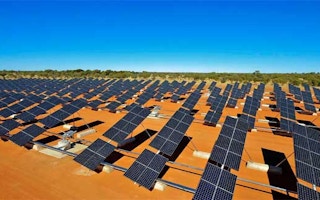The ACT’s proposed solar farms would reduce the risk of bushfire, a sustainable energy expert has said.
The territory is set to have solar farms operational across more than 100 hectares by 2015, including one near the 100-home Uriarra Village, and residents have queried whether the infrastructure would hinder firefighters and pose a risk in a blaze.
The Australian National University’s Andrew Blakers said less grass than the surrounding rural areas - but a need to maintain some growth, to avoid dust obscuring sunlight - meant the solar farms lowered the chance of fire spreading.
“The risk of fire goes down compared to open grassland, because there’s less grass - roughly one-third less grass,” Professor Blakers said.
“I think the risk of grass fires is very low, and the flammability is very low - the materials are glass, silicon, steel and aluminium and concrete - with a tiny little bit of plastic around each cell.”
Professor Blakers, director of ANU’s centre for sustainable energy systems, said any fire at one of the solar farms would pose no chemical risks to nearby residents. “The cells would be damaged in fire, but don’t burn themselves and there are no toxic chemicals,” he said.
The ACT Emergency Services Agency said solar panels bring some risk of ignition and electrocution, but fire was more likely to come from surrounding vegetation.
“As with all electricity infrastructure, solar panels carry some ignition risk but the resulting fire is not intense - the main fire risk would come from the surrounding fuel load [grass and other vegetation],” the spokesperson said.
“With electricity infrastructure, there is always a risk of electrocution, but this can be mitigated by strategies such as isolation switches and covering the panel.
“As part of ensuring appropriate response capability, fire service crews would be expected to undertake on site familiarisation with any new commercial solar facility following construction.”
The ESA spokesperson said solar farms would be required to manage vegetation to maintain an inner and outer asset protection zone, lessening fire risk in accordance with the requirements of the ACT’s Strategic Bushfire Management Plan.
The management plan does not refer to solar panels themselves.
The Royalla Solar Farm on the Monaro Highway is planned to have 83,000 solar panels, the Mugga Lane Solar Park at Tuggeranong is set to have 53,000, and the OneSun Capital Solar Farm near Uriarra Village will have 26,100 on current plans.
Uriarra Village had 17 of its then 23 homes destroyed in the 2003 bushfires, with sprinklers now in every dwelling and a bigger fire buffer zone.
Professor Blakers was a forest worker for three summers at Uriarra Village before the devastating blaze and doubted a similar fire at the site would ever occur. “That fire would never go through again like that because the pine forests are gone.” A spokeswoman for the national Clean Energy Council said solar power had been used in Australia for several decades, with no evidence of solar increasing bushfire risk.










